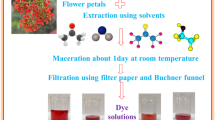Summary
According to the reaction of coloured flowers in media of varying hydrogen-ion concentration, their anthocyanins can be differentiated into two main groups, which may conveniently be called the blue and the red.
The anthocyanin of the blue group is a lake red at pH 3, passing through pink and violet to blue at about pH 7, and to green at the alkaline end of the series; the green being due to influence on the blue of flavones, which are yellow in alkaline media.
That of the red group is a vermilion red at pH 3, and passes through varying shades of red and pink to brownish purples in the more alkaline media. There is no blue or green at any hydrogen-ion concentration, and the brownish tints arc caused by admixture of the yellow flavones. Flowers of intermediate shades of purple to magenta or pink contain for the most part both blue and red anthocyanins in varying proportions.
It need not therefore be assumed that the sap of the purple or red flower is necessarily more acid than that of the blue flower, although in some cases the blue pigment alone may be present, but appear violet or purple-red on account of the acidity of the sap.
Similar content being viewed by others
Reference
“H-ion concentration and growth,”Science Progress, 1925, XX, 58 with references.
Reference
Willstäter: numerous articles in German chemical journals, and extensively quoted by Onslow inThe Anthocyanin Pigments of Plants, 2nd edition, 1925.
Reference
Lathouwers, for example, inCampanula medium, (Acad. Roy. des sciences de Belgique, 1922, T. IV, fasc. 8), recognises two main colours, violet and red, ascribing to the violet a factor which renders the sap more alkaline than that of the red flower; bnt he offers no proof that this is actually the case.
Author information
Authors and Affiliations
Rights and permissions
About this article
Cite this article
Buxton, B.H., Darbishire, F.V. On the behaviour of “anthocyanins” at varying hydrogen-ion concentrations. Journ. of Gen. 21, 71–79 (1929). https://doi.org/10.1007/BF02983358
Issue Date:
DOI: https://doi.org/10.1007/BF02983358




